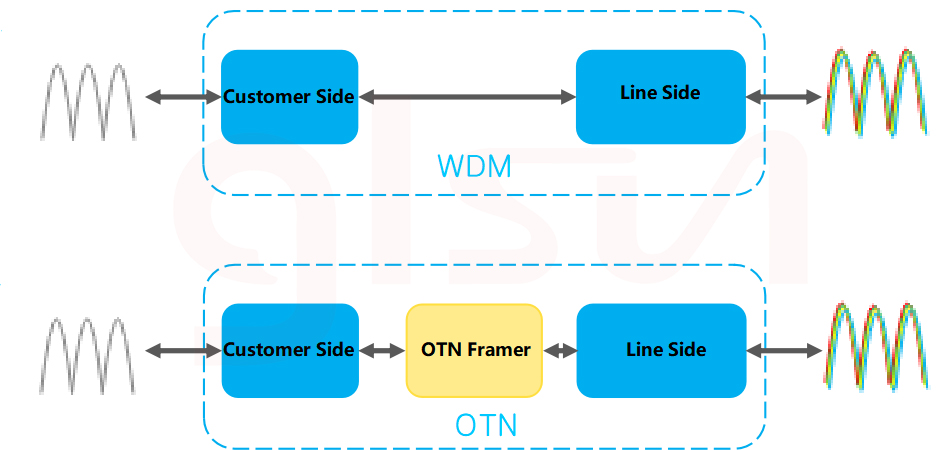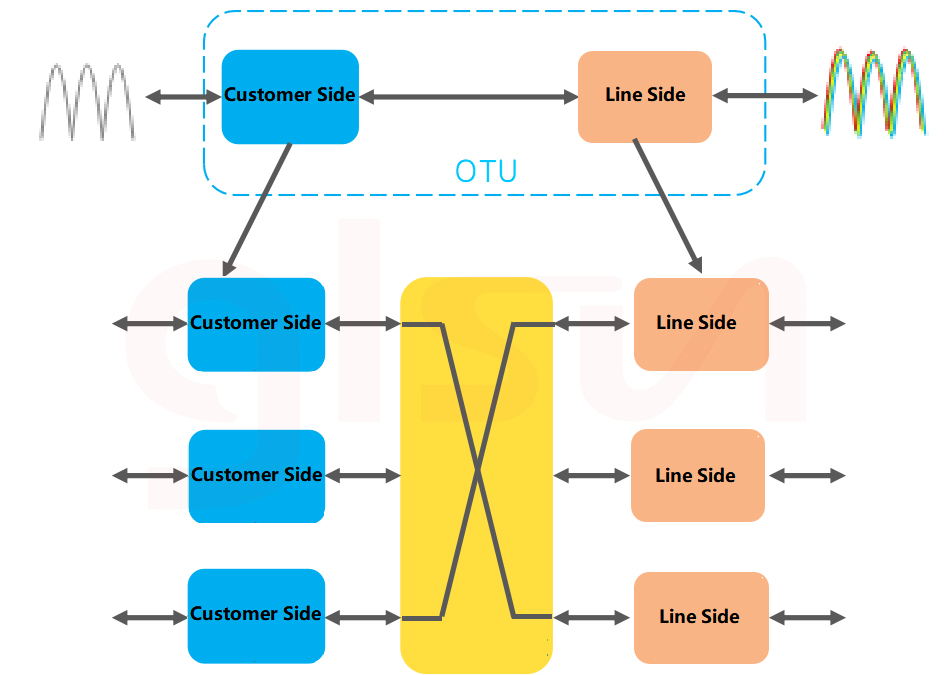Large-capacity Transmission Technology - WDM/OTN
2023-03-03
WDM (Wavelength Division Multiplexing) is a technology that uses different optical waves to carry different services and realizes simultaneous transmission of multiple services in the same optical fiber. OTN (Optical Transport Network) can be regarded as an optimized and upgraded version of WDM.
What is WDM?
If the optical fiber is compared to a highway, the light waves used to transmit services in the WDM system are compared to trucks, and different transmission services such as blog, video, and wechat are equivalent to packages to be transported, and these packages are directly placed on different trucks. If these trucks want to enter the optical fiber transmission regardless of the lanes, then crowding in will cause chaotic traffic flow on the entire expressway and affect the transmission efficiency. Different transmission services can be transmitted simultaneously on the same optical fiber with WDM. It is equivalent to divide the lanes for different vehicles on the expressway, allowing different vehicles to run on different lanes at the same time, improving transmission efficiency.

To ensure smooth traffic, it is necessary to distinguish lanes so that different vehicles can go their own way. Similar to the division of wagon lanes and car lanes in highway traffic, lane division in the WDM system is divided into CWDM (Coarse Wavelength Division Multiplexing) and DWDM (Dense Wavelength Division Multiplexing) , the former has a relatively large wavelength interval, generally 20 nm, while the latter has a small interval, generally less than 0.8 nm.
What does a WDM system consist of?
WDM system generally consists of OTU (Optical Transponder Unit), multiplexing/demultiplexing unit, monitoring channel, and optical amplification unit. To transmit services in WDM, it is first necessary to send the services to OTU unit, and convert the signals into standard optical wavelength signals recognized by WDM.
The standard optical wavelength signal is transmitted to the multiplexing unit, and enters different channels through multiplexing. The transmission status needs to be monitored through the monitoring channel to ensure normal service transmission. For a long distance transportation, it is also necessary to use the optical amplifier to regenerate and amplify the signal to improve the attenuation of optical signal and extend the transmission distance. When the service is transported to the terminal, it is converted into customer service signals by OTU.
What is OTN?
From the above brief introduction, it is not difficult to conclude that the biggest advantage of WDM technology is that it makes good use of optical fiber resources and can provide large-capacity data transmission capabilities. But WDM still has some following disadvantages:
The WDM system is weak to monitor, manage and maintain services. If a service is transmitted on a designated channel of the WDM system, the channel cannot be used by other services, which will cause waste of resources.
With the development of communication networks, the amount of data on the data network has increased rapidly. In order to develop the potential of WDM and improve its ability of WDM, OTN as a new technology was born. Its upgrade function is mainly shown in the following two aspects:
1. Adding operation and maintenance rules. The specific measures are to increase the frame structure and improve the monitoring, management and operation and maintenance capabilities of the business.

WDM vs. OTN
In WDM system, only the service without wavelength information entering the WDM system is converted into a service with wavelength information, which is sent to the WDM system for transmission. That is to say, the WDM system has no supervision mechanism for the transmitted services, and only guarantees that the services can be transmitted to the receiving end.
The services entering the OTN system will be packaged according to the OTN frame structure requirements, that is, the information of monitoring, management, operation and maintenance will be added, and then converted into the services with wavelength information and sent to the OTN system for transmission.
2. Increase the electrical crossover function, so that the OTN system can process customer service signals and WDM signals separately.

WDM system can transmit customer services. First of all, it needs to o convert customer service signals into WDM signals. When the traditional WDM system processes this function, it is directly realized through the same board, and each customer service needs to occupy a optical wave carrier. When there are more and more types of services on the network, in order for these services to be transmitted in the WDM system, on the one hand, it is necessary to develop new boards to carry these services, which will increase the cost of network construction. On the other hand, these services will also occupy more optical waves, resulting in resource strain. Therefore, the OTN system introduces an electrical crossover function, which is like adding a dispatch center to a traditional WDM transportation system. The dispatch center packs and dispatches different services entering the OTN transport system into different optical wave carriers.
Advantages of dispatching center: when the network adds new customer services, it only needs to add customer-side boards for accessing new services, and borrow the existing board on the line side to transport services to save the network construction cost. Meanwhile, when any channel is idle, customer services can be loaded to the channel at any time through the dispatch center to avoid empty-load operation and waste of resources.
In short, OTN is actually an optimization of WDM, which further improves the operation and maintenance capability and flexible resource scheduling capability of WDM system. With the rapid expansion of information and data, WDM/OTN technology is serving as a large-capacity transportation system for data network, constantly transmitting information and data with higher reliability, higher flexible scheduling ability and higher resource utilization.







